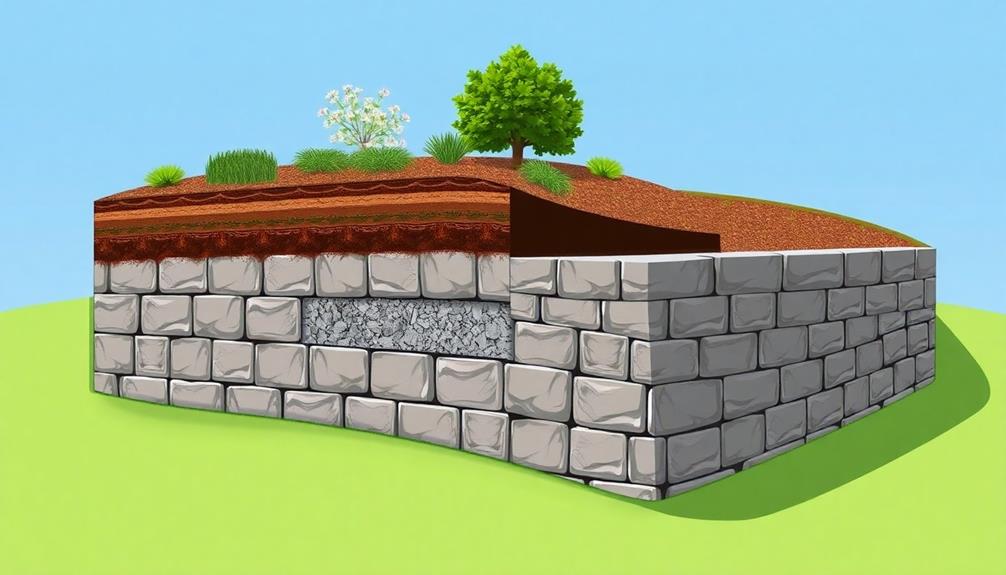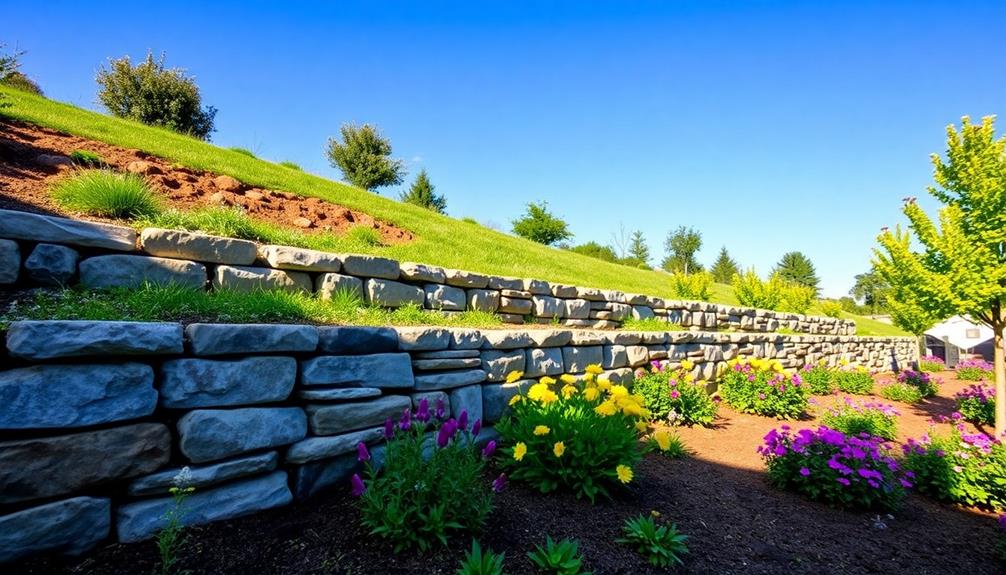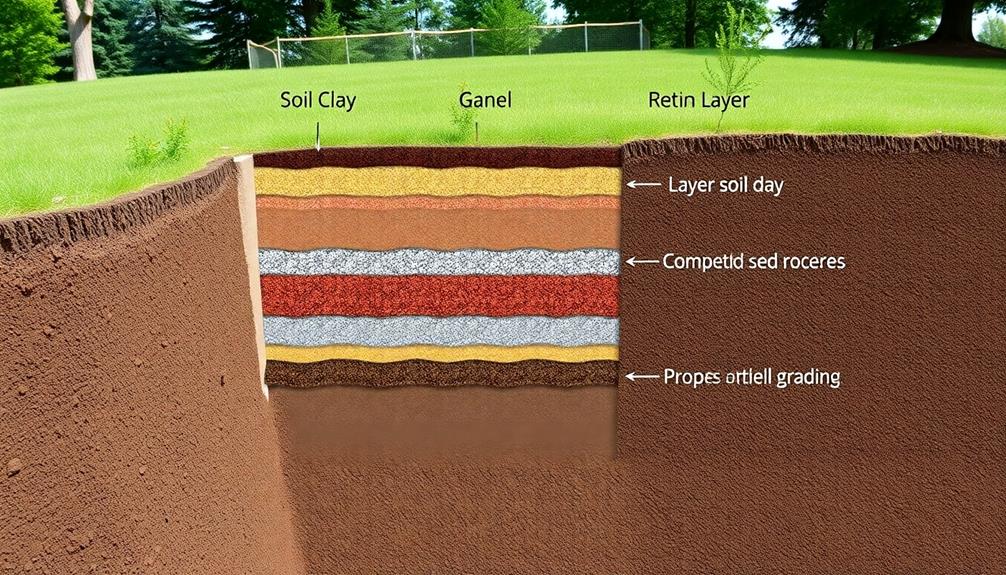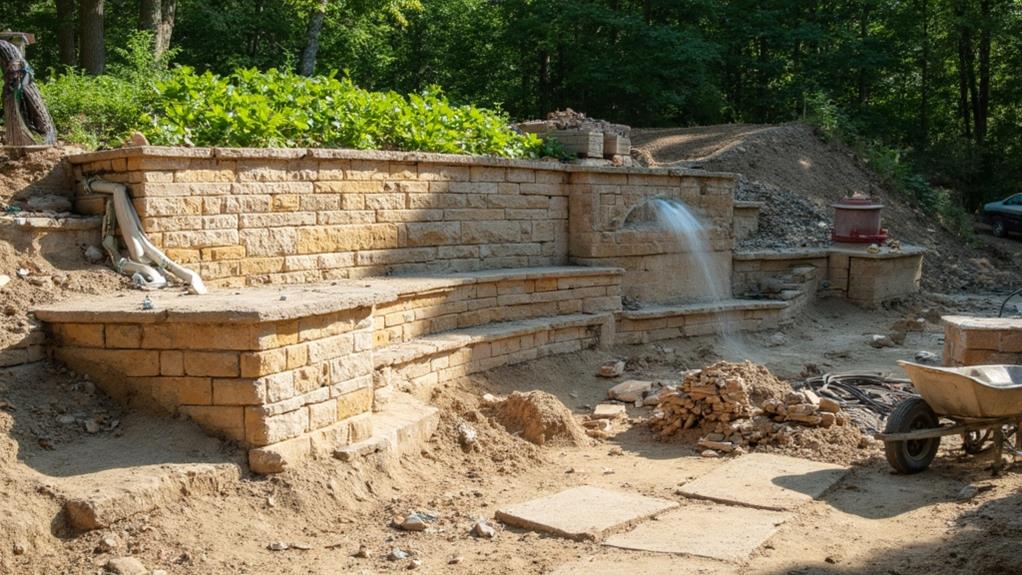Constructing a reliable retaining wall requires an integrated approach that emphasizes resilient design, appropriate material selection, proficient construction techniques, and ongoing maintenance. Key practices include conducting a thorough site analysis to address soil conditions and employing advanced modeling techniques such as Finite Element Analysis for structural integrity. Material choices must align with environmental conditions and aesthetic goals, while construction methods should be tailored to the wall type, ensuring stability and effective drainage. Regular maintenance and inspection are vital to managing any structural distress, and landscaping integration should enhance aesthetic appeal. Understanding these fundamentals provides an extensive grasp of effective retaining wall strategies.
Table of Contents
ToggleWalls Contractor Highlights
- Conduct thorough site analysis to assess soil conditions and stability for effective design.
- Select durable materials like concrete or natural stone, considering environmental conditions.
- Implement robust drainage systems to manage water flow and prevent erosion.
- Collaborate with civil engineers and landscape architects for comprehensive planning.
- Establish regular maintenance routines to promptly address any structural issues.
Retaining Wall Definition

Retaining walls are indispensable structural elements designed to stabilize soil and manage water flow, serving both functional and aesthetic purposes in various landscapes. For example, boulder walls are a versatile option, offering a natural, rustic aesthetic alongside inherent strength and durability.
These walls come in a variety of types, including gravity, cantilevered, and anchored, each utilizing different materials such as concrete, stone, and timber to suit specific environmental and architectural needs. Effective design and engineering are paramount to guarantee structural integrity, accounting for factors like soil conditions, load-bearing requirements, and drainage solutions to prevent failure and enhance longevity.
Purpose and Functionality
In the domain of civil engineering and landscape architecture, one might encounter the critical structure known as a retaining wall—an important component designed to support the earth laterally so that it can maintain different levels on either side. The primary purpose of a retaining wall is to prevent soil erosion and manage the gravitational forces that act upon the shift in terrain. Specifically, these walls are essentials in areas subject to varying elevations where the risk of land slippage presents a tangible threat to safety and infrastructure.
Functionality extends beyond mere soil retention, as these structures contribute to stability in landscapes and provide an aesthetically pleasing boundary to gardens and terraces. They enable productive land use on slopes and are instrumental in creating flat zones for agriculture, recreation, or construction. Additionally, retaining walls act as protective barriers that redirect water flow, mitigating potential damage from flooding or erosion. They play a subtle, yet pivotal role in enhancing property values by increasing usable land space and improving the overall aesthetic of the property.
Thus, a retaining wall serves as a blend of structural integrity and visual enhancement, instilling resilience in environments otherwise at risk from natural forces.
Types and Materials
Exploring the diverse types and materials used in retaining wall construction provides insight into their adaptability and efficiency. Retaining walls, essential for managing soil and preventing erosion, come in various forms, each serving unique functions and suited for distinct environmental conditions. Common types include gravity walls, which rely on their substantial mass to resist pressure, and cantilever walls, characterized by reinforced steel structures that leverage horizontal and vertical forces. Gabion walls, made of wire mesh enclosures filled with rocks, epitomize adaptability and aesthetic appeal, often chosen for environments requiring both functionality and visual enhancement.
Material selection profoundly impacts the effectiveness and longevity of retaining walls. Concrete is predominant, offering unmatched strength and durability, often augmented with decorative finishes to blend with landscapes. Timber, though less enduring than concrete, presents a natural appeal for residential settings with a less severe load-bearing requirement. Natural stone, synonymous with elegance and resilience, is frequently employed in traditional settings, providing both structural integrity and aesthetic value. The incorporation of modern composite materials has introduced lightweight and corrosion-resistant options, appealing to eco-conscious communities. Consequently, selecting appropriate materials and types enables these structures to serve their intended purpose effectively while enhancing the environment they occupy.
Design and Engineering
The design and engineering of retaining walls are fundamental to their function as pivotal elements in landscape architecture and civil engineering. They provide a structural solution to managing soil elevation changes and mitigating soil erosion, enhancing both the functionality and aesthetic appeal of landscapes.
Well-executed retaining wall design incorporates a deep understanding of geotechnical principles—addressing aspects like load-bearing capacity, lateral earth pressure, and drainage. Engineers must critical that the wall design accommodates various forces, including gravity, soil pressure, and water load, thereby confirming stability and safety.
In crafting the ideal retaining wall, engineers often begin with a thorough site analysis, evaluating soil type, slope steepness, and climate impact, which informs material choices and construction methodologies. It is imperative for these professionals to apply precise calculations and modeling, using tools such as Finite Element Analysis (FEA) for structural integrity appraisal.
Additionally, retaining wall designs must comply with local building codes and environmental regulations to foster community cohesion and trust.
Benefits

A well-constructed retaining wall offers several significant advantages, particularly enhancing property value through the introduction of increased usable space and improved landscape aesthetics. These structures are versatile, allowing for the creation of gardening, patios, and parking.
Enhances Property Value
When strategically integrated into a property's landscape, retaining walls can extensively enhance its value. These structures, crafted with a blend of aesthetic appeal and functional elegance, transform ordinary spaces into harmonious environments. By delineating spaces and creating visually mesmerizing terraces, retaining walls offer a platform to showcase expert landscaping.
This transformation not only elevates the property's visual charm but also considerably boosts its market appeal, capturing potential buyers' interest who seek properties that stand out.
In a competitive real estate market, the addition of a well-designed retaining wall can be crucial in positioning a property above its peers. These walls add structural diversity, often conjuring a sense of timelessness that resonates with those who value both beauty and durability. As a result, homeowners often find these enhancements lead to substantial returns on investment, as prospective buyers are willing to invest in a property with fewer landscaping concerns.
Moreover, retaining walls can disclose opportunities for creative outdoor living spaces. This inclusion can transform underutilized areas into functional spaces for entertainment, relaxation, or gardening. Consequently, this can create a sense of belonging among residents and guests, who may feel undeniably drawn to a property that actively engages the outdoor environment.
Prevents Soil Erosion
By serving as a formidable barrier, retaining walls play a crucial role in mitigating soil erosion on sloped landscapes. These structures are essential in maintaining landscape stability, preventing the downslope movement of soil resulting from water runoff. Homeowners and landscape architects alike understand the importance of such barriers, especially when facing the challenges posed by gradient terrains.
Retaining walls contribute to erosion prevention by offering the following benefits:
- Water Diversion: By directing water away from vulnerable areas, these structures tremendously reduce soil erosion, promoting the health and longevity of the surrounding land.
- Soil Stabilization: Retaining walls hold the soil in place, countering natural gravitational forces and minimizing the risk of landslides, which would otherwise threaten landscape integrity.
- Vegetation Support: Offering a stable base for planting, retaining walls facilitate the growth of vegetation whose roots further anchor the soil, enhancing erosion control efforts.
- Drainage Support: By incorporating drainage solutions, retaining walls manage water accumulation effectively, allowing excess water to escape, thereby preventing saturation and subsequent erosion.
Increases Usable Space
While retaining walls are instrumental in thwarting soil erosion, they offer an equally valuable benefit by greatly increasing the available usable space on sloped properties. Often, sloped or uneven land poses a vast challenge for property owners, limiting the functional use of their outdoor environments for leisure, gardening, or storage.
Implementing retaining walls adeptly addresses these challenges by transforming steep gradients into flat, stable terraces, thereby harnessing untapped potential.
This expansion of usable space is not merely a matter of practicality but also a reflection of the maximization of your property's value. Whether it's creating a flat area for a children's play zone, establishing a gardening space, or optimizing the land for larger gatherings, the possibilities become endless with a well-constructed retaining wall. Well-structured terracing offers multiple tiers of functional land, often making once-unapproachable areas accessible and inviting.
Moreover, retaining walls can encourage a sense of community and cohesion within neighborhoods, where homeowners take pride in their enhanced landscapes. As a result, retaining walls not only serve as a functional feature but enormously contribute to the livability and adaptability of your outdoor space, fostering a shared aesthetic and lifestyle improvement.
Boosts Landscape Aesthetics
Elevating the visual appeal of a property, retaining walls substantially enhance the landscape aesthetics by introducing structure and form to otherwise chaotic terrain. This improvement is not merely superficial; the integration of retaining walls offers cohesion and continuity across landscape designs, embedding a sense of order and elegance.
In the domain of landscaping, a well-designed retaining wall can transform a nondescript area into a focal point, adding critical value to the environment and fostering a sense of pride and belonging among residents. Through strategic placement and thoughtful design, retaining walls align with the natural aesthetics of the surroundings, effectively marrying utility with beauty.
Consider the following benefits of retaining walls in enhancing landscape aesthetics:
- Variety of Materials: Retaining walls can be constructed from diverse materials such as natural stone, brick, or wood, offering endless aesthetic possibilities to match the homeowner's vision.
- Architectural Harmony: They seamlessly integrate with architectural styles, blending with existing structures and enhancing the overall theme of the property.
- Color and Texture: Walls introduce varied color palettes and textures, breaking the monotony and adding dimension to the landscape.
- Visual Interest: They create eye-catching elevation changes, which contribute to a dynamic and visually appealing outdoor space.
Soil Type Considerations

When constructing a retaining wall, understanding soil type is essential as it directly influences soil stability assessments, effective drainage management, and the adoption of appropriate construction techniques specific to varying soil conditions. For example, clay soils may require additional drainage solutions to mitigate water retention, while sandy soils might benefit from reinforcement to safeguard structural integrity. The table below highlights fundamental considerations based on soil type:
| Soil Type | Consideration | Recommended Action |
|---|---|---|
| Clay | High Water Retention | Improved Drainage |
| Sandy | Low Cohesion | Structural Reinforcement |
| Silt | Moderate Erosion | Erosion Control Measures |
| Loam | Balanced Properties | Standard Techniques |
Understanding these factors guarantees robust and durable wall construction tailored to specific environmental conditions.
Assessing Soil Stability
Understanding soil stability is a cornerstone of successful retaining wall construction, as different soil types present varying challenges and requirements. Recognizing these intricacies allows for the creation of a strong foundation, maintaining the long-term durability of the structure. Examining soil stability involves meticulous examination and testing to determine the specific composition and behavior of the soil on-site.
- Soil Classification: Identify the type of soil by determining its composition, such as clay, silt, sand, or gravel. Each soil type reacts differently to moisture and load, influencing the wall's design and construction approach.
- Soil Testing: Engage in a series of tests, such as the Proctor test for compaction and the Atterberg limits for plasticity, to understand the soil's mechanical properties. These evaluations help predict how the soil will behave under stress and environmental changes.
- Load-bearing Capacity: Calculate how much weight the soil can support without undergoing excessive movement. This will inform the necessary depth and reinforcement needed for the retaining wall foundation.
- Compaction Evaluation: Assess the existing soil density to confirm it has the required compactness for stability. Proper compaction prevents potential settlement issues that could compromise the wall's integrity.
This methodical approach to examining soil stability helps foster a sense of belonging within the community of property developers, contractors, and engineers, who rely on precise data to create sustainable structures.
Drainage Management Importance
Effective drainage management is essential in retaining wall construction, as it directly influences the structure's stability and longevity. The presence of water behind a retaining wall can increase lateral pressure against the wall, potentially leading to undue stress and structural failure. As a result, understanding the soil type is pivotal in tailoring drainage solutions to match specific needs.
Cohesive soils, like clay, tend to retain water, necessitating robust drainage systems to prevent water accumulation. Conversely, sandy soils, which drain more readily, may require less intensive drainage measures.
Considering soil permeability allows for strategic planning. In low-permeability soils, incorporating drainage pipes and gravel backfill can facilitate efficient water movement, ensuring the wall remains uncompromised over time. In addition, the integration of a geotextile fabric can help prevent soil erosion while maintaining the integrity of drainage systems by ensuring that only water passes through.
For our community of builders and landscape architects, adhering to best practices in drainage management fosters a sense of belonging, as we collectively aim to execute projects with precision, reliability, and longevity in mind. Properly managed drainage not only protects the investment but also reinforces the wall's role in harmonizing with its environment.
Soil-Specific Construction Techniques
Tailoring construction techniques to specific soil types is a critical aspect of building a durable retaining wall. Understanding the unique characteristics of soil informs the design, guaranteeing stability and longevity. Soil-specific construction techniques provide the foundation for a robust structure, establishing peace of mind for builders and homeowners alike. Without accounting for these variances, retaining walls may succumb to unforeseen pressures or failures.
For those invested in proper construction, consider the following principles:
- Clay Soils: Characterized by high cohesiveness and low drainage, clay requires reinforcement and precise drainage systems. Implementing geogrid technology or using lightweight backfill can enhance wall stability while mitigating hydrostatic pressures.
- Sandy Soils: Often lacking cohesion, sandy soils necessitate additional anchoring solutions. Utilizing thicker bases and incorporating mechanical interlocking units can counteract potential erosion and sliding.
- Silty Soils: Due to their fine particles, silty soils are prone to water logging and instability. Employing drainage layers using gravel or aggregates helps counteract these challenges, maintaining the wall's integrity.
- Rocky Soils: Facilitating natural stability, rocky soils demand flexible footing that accommodates ground shifts. Aggregate backfills and precision alignment techniques help certify consistency and durability.
Adhering to these soil-specific considerations not only solidifies structural safety but also fosters a connection between project and environment, reinforcing the community's shared goal of sustainability and resilience.
Walls Contractor FAQ
What Materials Offer the Longest Lifespan for Retaining Walls?
Selecting materials with a long lifespan for retaining walls is essential for durability and safety. Concrete blocks, natural stone, and reinforced concrete are esteemed choices, renowned for their strength and resistance, fostering enduring, reliable structures in landscaping projects.
How Can I Prevent Water Drainage Issues With Retaining Walls?
Proper drainage systems, like gravel backfill and perforated pipes, are essential to mitigate water buildup behind retaining walls. Incorporating weep holes and ensuring proper grading enhances moisture management, promoting structural integrity and longevity, fostering a sense of security.
What Safety Measures Are Essential During Retaining Wall Construction?
Prioritizing safety in retaining wall construction guarantees a secure environment for all involved. Essential measures include proper site assessment, appropriate personal protective equipment, continuous monitoring for structural stability, and adherence to all relevant building codes and regulations.
How Do I Determine the Optimal Height for a Retaining Wall?
Determining the ideal height for a retaining wall involves evaluating soil type, slope gradient, and anticipated load. Consult engineering guidelines to cultivate a sense of confidence and cohesion within the construction community, ensuring stability and lasting functionality.
What Are Common Signs of Structural Failure in Retaining Walls?
Common signs of structural failure in retaining walls include visible cracks, bulging, or tilting, water seepage, and soil erosion at the base. Observing these issues early fosters a sense of responsibility and connection with the community's structural integrity.







